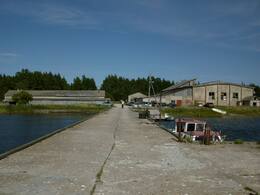Recollections of Olev Metsmaa
The base of seaplanes was built in Papissaare and the air defense batteries of Kiirassaare were built.
The seaplane harbour was built in Papissaare and air defence batteries were erected in Kiirassaare.
At first, the soldiers were housed in and around Kihelkonna. The locals were beginning to feel really jammed together. A lot of construction workers were brought in from the mainland, even from as far afield as Setomaa. Construction work stalled when the war broke out. The workers returned home and the military had to make do with the complex as it was, unfinished. At this point the situation became very unnerving. The military started moving troops here and there. The small but aggressive German and Finnish fighter planes could be seen flying overhead nearly every day. The skies echoed with the rumble of aircraft, the rattle of gunfire and explosions from anti-aircraft shells. At one point, an anti-aircraft shell detonated near a small Finnish plane, which looped the loop before it came hurtling down. A machine gun could be heard firing for 10 minutes before smoke began rising from Papissaare. The Russians were certain the plane had crashed. But the people in Vilsandi could see that the little aircraft had dropped down to sea level, carried on flying at a very low altitude and opened fire on the four or five aircraft docked at the harbour. The Russians had been duped. German fighters caused a lot of trouble at the base in Papissaare, disguised as Russian aircraft. They flew at very low altitudes and at very high speeds. The battery in Kiirassaare couldn't aim that low, so the Germans wreaked their havoc with no one to stop them. This continued into autumn; September, I think.
One day, black smoke began to rise from Papissaare, accompanied by a peculiar crackling noise. It sounded like a lorry stacked with timber was driving along the cobbled Kihelkonna-Papissaare road. The barracks and ammunition warehouses had presumably caught on fire. Things quickly turned serious.
Since our yard was full of thick smoke from Papissaare and it was becoming impossible to breathe, my father told me to move the carts, which were piled high with hay, away from the threshing barn to some bushes in the shade so as to avoid the farm catching fire. I released the hook on the rear door and the doors flung open with a crash. I was shocked to see dozens of sailors stumbling around in the bushes, seemingly even more shaken than I was, running frantically towards the road to Lümanda, some bareheaded, some even without their tunics. I didn't catch notice any of them bearing arms.
After a while the smoke thinned. A train of soldiers and horses was moving along the Lümanda road, everyone hurrying along.
They were all still very agitated the following night: no one could get to sleep. By morning the situation had calmed down hereabouts, but the approaching sound of warfare could be heard from over yonder. At noon we saw the first German troops, riding bicycles like tourists along the Kihelkonna-Lümanda road towards Sõrve. This left me feeling that the end of the war was near. Unfortunately, I was wrong. No one wanted to believe that this might be the start of a much bigger war.
Memories of Olev Metsmaa (www.militaar.net, copy in the possession of E. Püüa)
Related objects
Papissaare Seaplane Base
This seaplane harbour is situated on Papissaare Peninsula, to which an historic cobbled road leads from the small borough of Kihelkonna.
Papissaare Seaplane Base, which formed part of Peter the Great's Naval Fortress, was established between 1912 and 1914. It comprised two aircraft hangars, equipment and ammunition warehouses, a fuel tank, an electric generator, barracks, a canteen, a bread factory and a bathhouse. In August 1914, nine aircraft were brought here from Liepāja. On 12 October 1917 German forces captured the base and destroyed most of the buildings. During the interwar era the complex was the site of Julius Teär's Shipyard.
On 24 October 1939, Soviet forces acquired the complex under the Mutual Assistance Pact and restored it as a seaplane harbour. The MBR-2 seaplanes of the 15th Aviation Squadron stationed here fought in the Finnish Winter War. In late summer 1941, German bombers obliterated the seaplanes. The Soviet squadron abandoned the base, setting it on fire as they did so. From 1940-1960 the whole peninsula was a restricted military zone. Later, the complex was used by the local fishing collective. Today the remaining buildings are in use as workshops and warehouses.
This historic seaplane harbour has become an important tourism port, providing passage to the unique island of Vilsandi.





